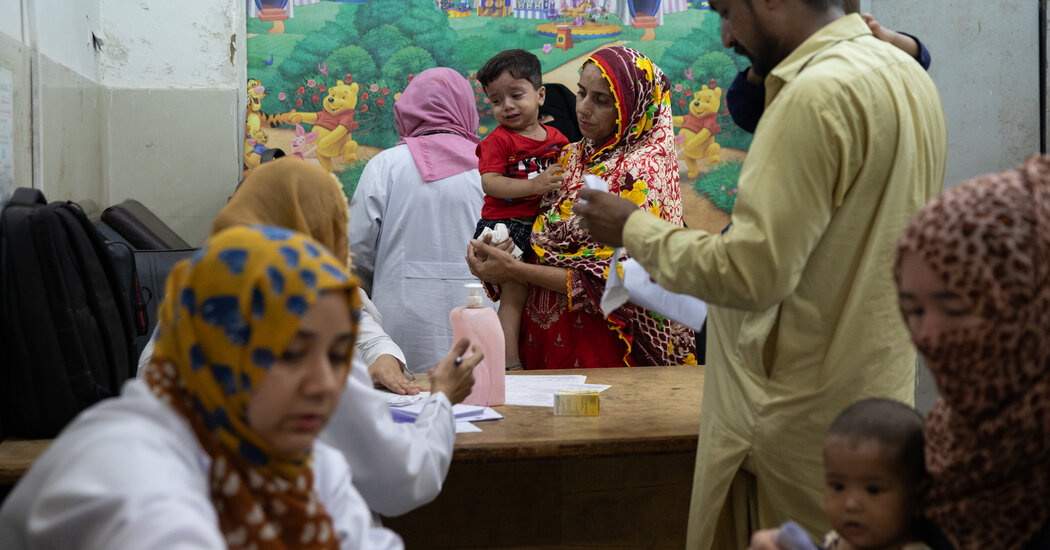Signs of the heat wave lashing the sun-drenched city can be seen in almost every corner of Karachi.
Hundreds of patients suffering from heat-related illnesses are flooding into hospitals every day, pushing them far beyond their capacity. Morgues overwhelmed by the influx of bodies are struggling to find space.
Frustrated residents have begun blocking roads with stones and sticks to protest the lack of electricity and drinking water. Even the normally bustling markets and streets have emptied as people refuse to leave their homes unless they absolutely have to.
Karachi, Pakistan’s largest city and economic heartland, is the latest to suffer from a scorching heatwave in South Asia this summer. It’s a stark reminder of the deadly toll climate change is taking on a part of the world that’s particularly vulnerable to its effects. The country is plagued by ineffective governance and wide economic disparities that have only exacerbated the suffering of its poorest citizens.
In a particularly severe eight-day period late last month, temperatures reached 104 degrees Fahrenheit (40 degrees Celsius), with high humidity adding to the misery. It was the hottest since 2015, a year in which officials reported more than 1,200 people died from heat-related causes in Karachi.
While temperatures still hover around 38 degrees Celsius, the sense of crisis persists.
“It feels like living in an oven,” said Akbar Ali, 52, a rickshaw driver who has transported many people suffering from heatstroke to hospital in recent weeks. “It’s horrible to see people collapsing in the streets.”
Karachi, a port city on the Arabian Sea, is known for its hot summers and monsoon floods. Such extremes are particularly hard on the 60 percent of residents who live in the city’s sprawling slums, where homes are shoddily built of concrete or tarpaulin and roads are unpaved.
But this summer has been particularly bad. During the intense heatwave from June 23 to 30, the city’s main morgue received about three times as many bodies as on a normal day, according to the Edhi Foundation, a charity known for its extensive mortuary operations and large ambulance fleet.
In total, the charity’s morgues received around 700 bodies in those eight days. While the cause of death was not clear in all cases, the timing was telling.
“This is a humanitarian crisis, but many deaths from heatwaves will not be officially recorded as heat deaths,” he said. Erum Haideran academic at the College of Wooster who has studied Karachi’s social challenges. “They are often categorized as ‘fever,’ ‘heart attack,’ or ‘child mortality,’ which obscures their true impact.”
In recent weeks, power outages in the slums have become more frequent and longer, ranging from six to 16 hours a day. Without power, millions of people cannot use the electric fans that provide some relief (air conditioning is rare). Frustration over the blackouts has prompted residents to regularly block major roads in protest.
The power outage is “catastrophic for everyone in these neighborhoods during a heat wave, but especially for babies, the elderly and pregnant women,” Ms. Haider said.
Water has also become scarce. Many neighborhoods are facing severe water shortages, making the lack of clean drinking water a public health crisis. In Karachi, a significant portion of the population relies on buying water from private companies via tanker trucks, as the city’s water infrastructure is unable to meet the needs of all residents. In the summer, even areas that normally receive piped water are forced to buy water due to shortages. The skyrocketing prices for water tankers add to the burden on already struggling communities.
“The cost of water tankers has doubled or even tripled,” said Mehmood Siddiqui, a teacher at a private school whose monthly salary is $143. “They are now charging $28 for a tanker of water that cost $14 last month. It is outrageous.”
Hospitals are flooded with patients suffering from heatstroke and severe dehydration.
“Patients are reporting symptoms such as high fever, weakness, gastroenteritis, vomiting and diarrhea in numbers far exceeding normal,” said Nasreen Gul, a nurse at Jinnah Postgraduate Medical Centre, the city’s largest government hospital.
Government officials have tried to downplay reports of large-scale deaths from heat waves. Karachi Commissioner Hassan Naqvi, citing data from government hospitals, suggested that the number of heat-related deaths was minimal.
Government officials have set up cooling centers across the city. Charities are also offering some relief to residents by setting up camps along the road to offer water spray, as well as glasses of cold water or Rooh Afza, a popular summer drink in South Asia.
Rain last Thursday brought relief to Karachi after afternoon temperatures peaked at 104 degrees Fahrenheit. But it also highlighted the city’s vulnerability to the summer’s other major weather problem: devastating floods.
“We can pray that rain will cool the weather,” said Ali Afzal, 44, a car mechanic in Karachi whose home was destroyed in the July 2022 urban floods caused by heavy rains. “But more rain poses another challenge, especially for city dwellers who are unprepared.”


